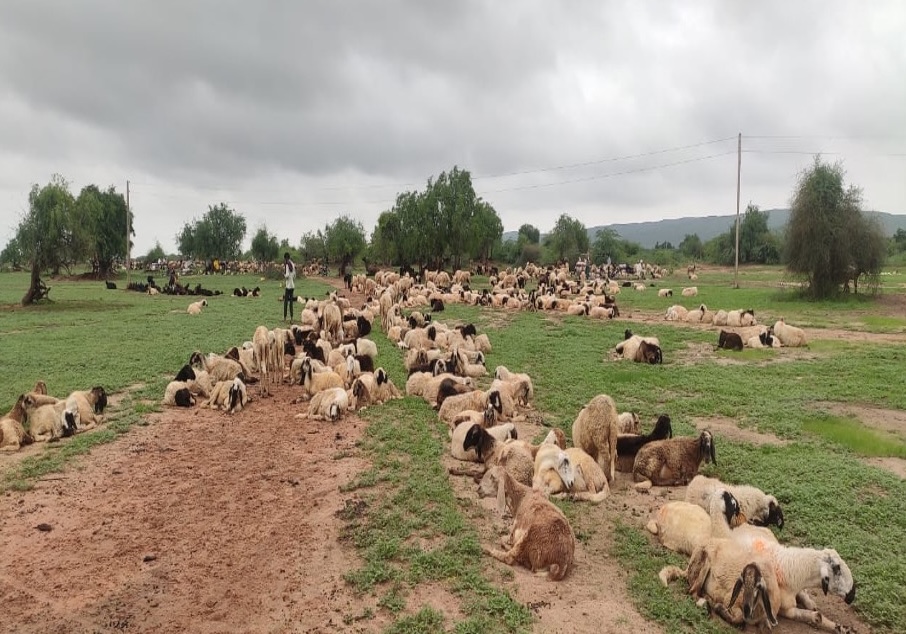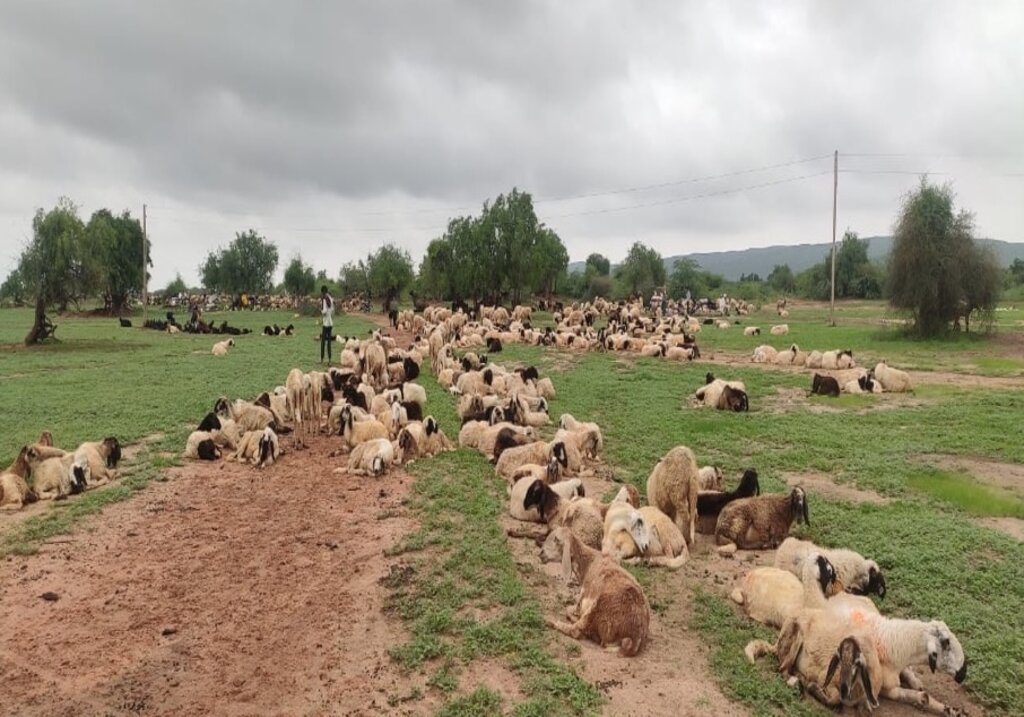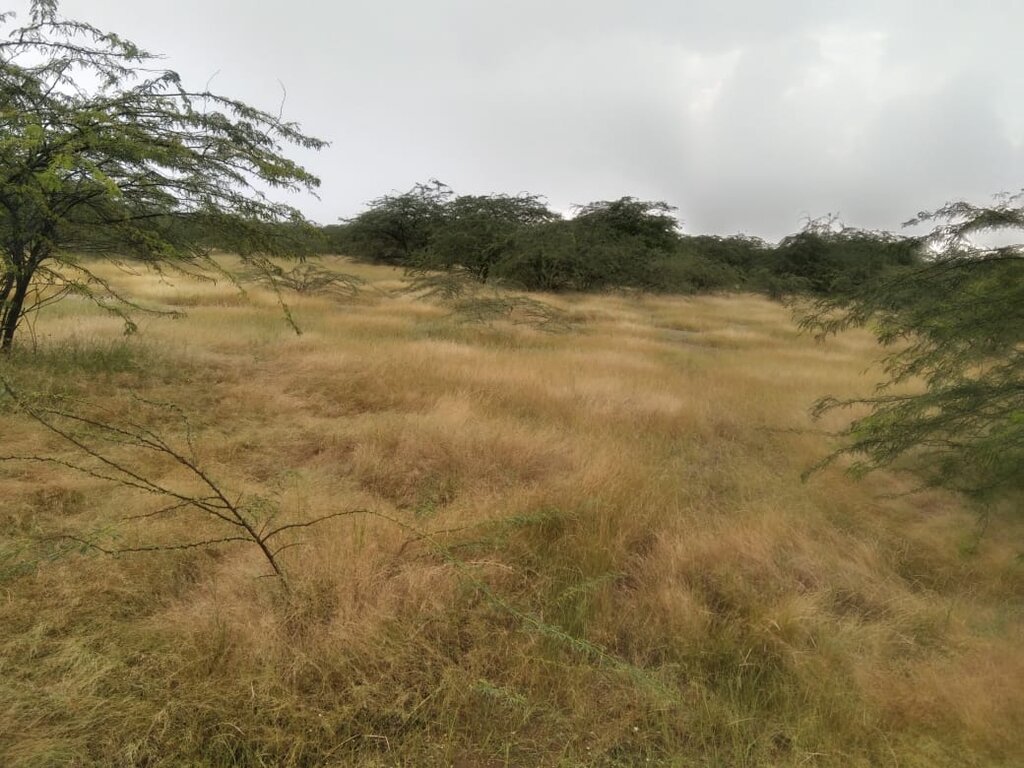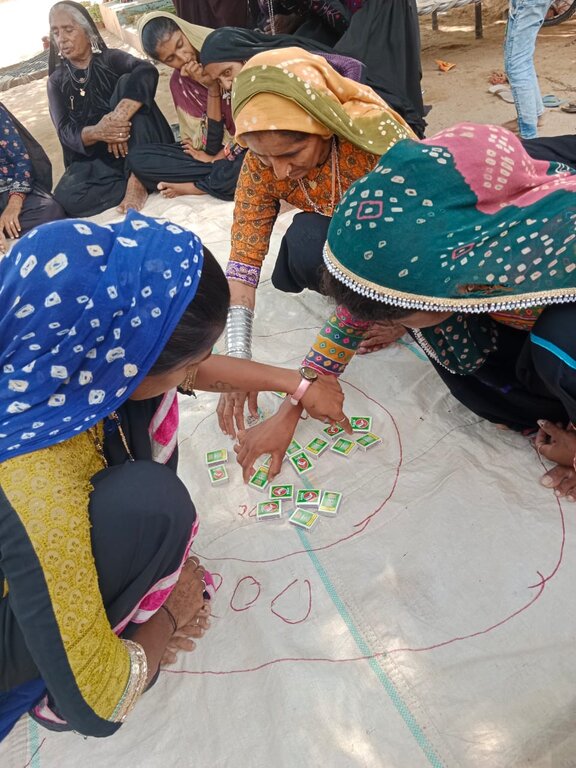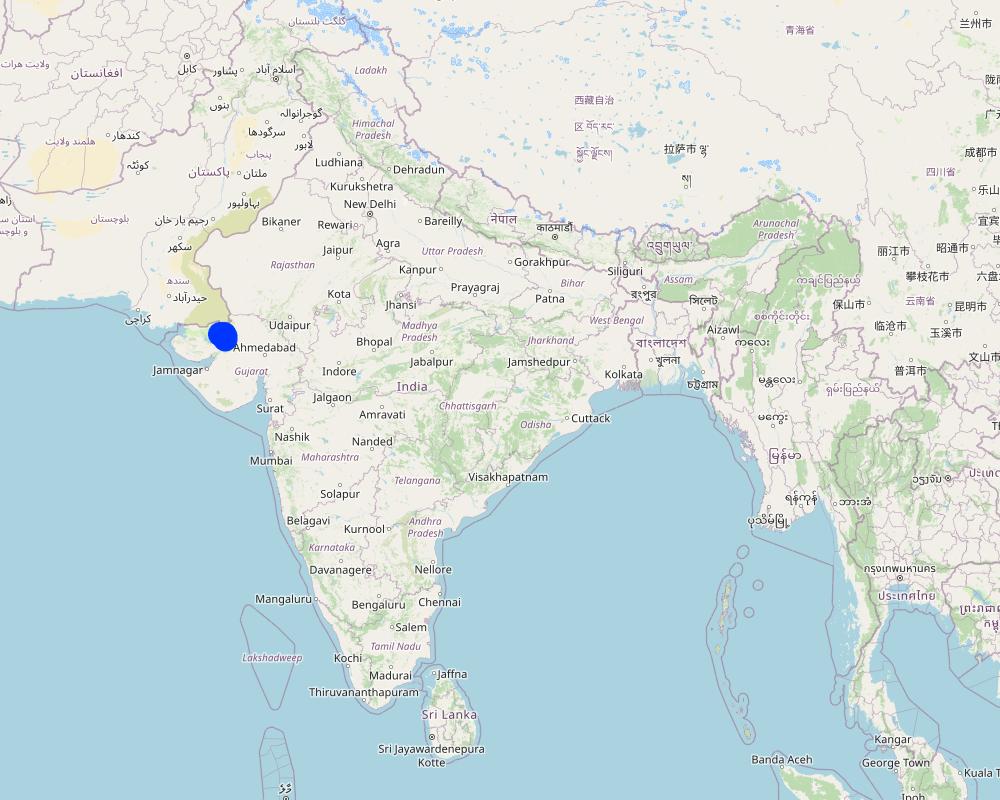TRANSFORMING VILLAGE WASTELAND INTO A RICH PASTURE [อินเดีย]
- ผู้สร้างสรรค์:
- การอัพเดท:
- ผู้รวบรวม: Bhavana Rabari
- ผู้เรียบเรียง: –
- ผู้ตรวจสอบ: Udo Höggel
Jamin Sudharana
technologies_7423 - อินเดีย
ดูส่วนย่อย
ขยายทั้งหมด ย่อทั้งหมด1. ข้อมูลทั่วไป
1.2 รายละเอียดที่ติดต่อได้ของผู้รวบรวมและองค์กรที่เกี่ยวข้องในการประเมินและการจัดเตรียมทำเอกสารของเทคโนโลยี
วิทยากรหลัก
Project Co-ordinator:
Desai Bhavana
Maldhari Rural Action Group
อินเดีย
Communication Officer:
Sheth Megha
MARAG - Maldhari Rural Action Group
อินเดีย
ชื่อขององค์กรซึ่งอำนวยความสะดวกในการทำเอกสารหรือการประเมินเทคโนโลยี (ถ้าเกี่ยวข้อง)
Maldhari Rural Action Group (MARAG)1.3 เงื่อนไขการใช้ข้อมูลที่ได้บันทึกผ่านทาง WOCAT
ผู้รวบรวมและวิทยากรหลักยอมรับเงื่อนไขเกี่ยวกับการใช้ข้อมูลที่ถูกบันทึกผ่านทาง WOCAT:
ใช่
1.4 การเปิดเผยเรื่องความยั่งยืนของเทคโนโลยีที่ได้อธิบายไว้
เทคโนโลยีที่ได้อธิบายไว้นี้เป็นปัญหาของความเสื่อมโทรมโทรมของที่ดินหรือไม่ จึงไม่ได้รับการยอมรับว่าเป็นเทคโนโลยีเพื่อการจัดการที่ดินอย่างยั่งยืน:
ไม่ใช่
2. การอธิบายลักษณะของเทคโนโลยี SLM
2.1 การอธิบายแบบสั้น ๆ ของเทคโนโลยี
คำจำกัดความของเทคโนโลยี:
Under the leadership of the Pastoralist Women Land Management Committee at village level, 100 acers of village wasteland were transformed into a rich pastures to be used by village livestock herds and, in this way providing food and livelihood security to local communities and restoring biodiversity within native grasses and indigenous livestock breeds.
2.2 การอธิบายแบบละเอียดของเทคโนโลยี
คำอธิบาย:
Overview
The initial project focused on 10 villages within Kutch District, Gujarat, Western India. Each of these villages developed 10 acres of associated common pastureland. In total, 100 acres were developed. The project offered local solutions to develop village wastelands (common term in India for degraded lands) into ecologically regenerated pasturelands. Village pastureland, developed in such manner was used for open and free grazing for livestock. This enhanced milk production thus generating income for village women and their families.
Process
MARAG formed a WPLMC (Women’s Pastureland Management Committee) in each village consisting of 10 members. Each WPLMC managed 10 acres of these common pasturelands in their respective villages. WPLMCs were trained and engaged in land mapping and demarcation through GPS, soil testing, land cleaning and land levelling, selection of native grass seeds, sowing of such grasses, and general maintenance and management of the land.
The rules and regulations for land management were determined by the WPLMCs. WPLMCs jointly decided to use 5 of 10 acres of each village gaucher (local term for pasture) to develop traditional grasses for small ruminants. Out of this, 2.5 acres were developed as fodder for large livestock and 2.5 acres were developed for drought tolerant species. Finally, the WPLMCs documented the regulation and use of pastureland and the responsibility of the management.
The following processes were employed for pastureland regeneration:
1.Silvipasture practice
2.Land treatment and afforestation
3.Reintroduction of traditional grass seeds.
4.Tapping of indigenous pastoral knowledge for grass development and breed conservation.
5.Forming and strengthening Women Pastureland Management Committees (WPLMC) at village level for project sustainability.
6.Using technology and capacity building of the WPLMC (e.g. GPS tools for land measuring, mobile app use for determining land fertility and water catchment etc.)
Livestock rearing can be a tool for the sustainable management of land, especially in arid and semiarid areas, by improving soil health, mitigating desertification and protecting the local ecosystem against invasive species. Sustanable livestock grazing breaks soil crust, increasing rain water absorpstion and converts grass into organic waste, increasing soil health and regenarating grasses by spreading seed.
Project Impact
1.Developed women leadership and management capacities as well as decision making throughout the project process.
2.Ownership of the pastureland development taken by pastoralist women.
3.Pastoralist women learning and using the smartphone for land mapping. Such knowledge is easily copied by other women in the village.
4.Traditional knowledge on pasture grasses women to deepen their knowledge on pasture management.
5.Biodiversity conservation through traditional knowledge.
6.Secured livelihood security and food sovereignty.
2.3 รูปภาพของเทคโนโลยี
2.4 วีดีโอของเทคโนโลยี
ชื่อผู้ถ่ายวีดีโอ:
Bhavana Rabari
2.5 ประเทศภูมิภาค หรือสถานที่ตั้งที่เทคโนโลยีได้นำไปใช้และได้รับการครอบคลุมโดยการประเมินนี้
ประเทศ:
อินเดีย
ภูมิภาค/รัฐ/จังหวัด:
Gujarat
ข้อมูลจำเพาะเพิ่มเติมของสถานที่ตั้ง :
Dhabda village of Kutch District
ระบุการกระจายตัวของเทคโนโลยี:
- ใช้ ณ จุดที่เฉพาะเจาะจงหรือเน้นไปยังบริเวณพื้นที่ขนาดเล็ก
Is/are the technology site(s) located in a permanently protected area?
ไม่ใช่
Map
×2.6 วันที่การดำเนินการ
ระบุปีที่ใช้:
2022
2.7 คำแนะนำของเทคโนโลยี
ให้ระบุว่าเทคโนโลยีถูกแนะนำเข้ามาอย่างไร:
- เป็นส่วนหนึ่งของระบบแบบดั้งเดิมที่ทำก้นอยู่ (> 50 ปี)
ความคิดเห็น (ประเภทของโครงการ เป็นต้น) :
It is rooted in traditional practices but now incorporates technology. Pastoralists use smartphones to map grazing lands, identify water catchment areas, and determine more fertile land.
3. การจัดประเภทของเทคโนโลยี SLM
3.1 วัตถุประสงค์หลักของเทคโนโลยี
- ลด ป้องกัน ฟื้นฟู การเสื่อมโทรมของที่ดิน
- อนุรักษ์ระบบนิเวศน์
- รักษาสภาพหรือปรับปรุงความหลากหลายทางชีวภาพ
- สร้างผลกระทบทางด้านเศรษฐกิจที่เป็นประโยชน์
- สร้างผลกระทบทางด้านสังคมที่เป็นประโยชน์
3.2 ประเภทของการใช้ที่ดินในปัจจุบันที่ได้นำเทคโนโลยีไปใช้
Land use mixed within the same land unit:
ใช่
Specify mixed land use (crops/ grazing/ trees):
- ปศุสัตว์ร่วมกับการทำป่าไม้ (Silvo-pastoralism)
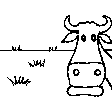
ทุ่งหญ้าเลี้ยงสัตว์
Extensive grazing:
- กึ่งโนแมนดิซึ่มหรือแพสโตแรลลิซึ่ม (Semi-nomadism/pastoralism)
ทุ่งหญ้าเลี้ยงสัตว์ที่มีการจัดการแบบเข้มข้นหรือการผลิตอาหารสัตว์:
- ทุ่งหญ้าเลี้ยงสัตว์ที่ได้มีการปรับปรุง (Improved pastures)
Animal type:
- buffalo
- cattle - dairy
- goats
- sheep
Is integrated crop-livestock management practiced?
ไม่ใช่
ผลิตภัณฑ์และบริการ:
- economic security, investment prestige
- milk
- whool
Species:
buffalo
Species:
cattle - dairy
Species:
goats
Species:
sheep
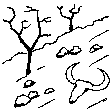
ที่ดินที่ไม่ให้ผลผลิต
ระบุ:
Village wasteland
3.3 Has land use changed due to the implementation of the Technology?
Has land use changed due to the implementation of the Technology?
- No (Continue with question 3.4)
3.4 การใช้น้ำ
การใช้น้ำของที่ดินที่มีการใช้เทคโนโลยีอยู่:
- จากน้ำฝน
3.5 กลุ่ม SLM ที่ตรงกับเทคโนโลยีนี้
- การจัดการปศุสัตว์และทุ่งหญ้าเลี้ยงสัตว์
- การปรับปรุงดิน / พืชคลุมดิน
- การจัดการน้ำบาดาล
3.6 มาตรการ SLM ที่ประกอบกันเป็นเทคโนโลยี
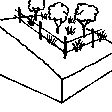
มาตรการอนุรักษ์ด้วยการจัดการ
- M2: การเปลี่ยนแปลงของการจัดการหรือระดับความเข้มข้น
- M3: การวางผังตามสิ่งแวดล้อมทางธรรมชาติและสิ่งแวดล้อมของมนุษย์
- M5: การควบคุมหรือการเปลี่ยนแปลงขององค์ประกอบของชนิดพันธุ์
3.7 รูปแบบหลักของการเสื่อมโทรมของที่ดินที่ได้รับการแก้ไขโดยเทคโนโลยี
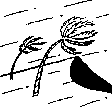
การกัดกร่อนของดินโดยลม
- Et (Loss of topsoil): การสูญเสียดินชั้นบน

การเสื่อมโทรมของดินทางด้านชีวภาพ
- Bc (Reduction of vegetation cover): การลดลงของจำนวนพืชที่ปกคลุมดิน
- Bh (Loss of habitat): การสูญเสียแหล่งที่อยู่
- Bq (Quantity/biomass decline): การลดลงของปริมาณหรือมวลชีวภาพ
- Bs (Quality and species composition): องค์ประกอบหรือความหลากหลายทางคุณภาพและชนิดพันธุ์ลดลง
3.8 การป้องกัน การลดลง หรือการฟื้นฟูความเสื่อมโทรมของที่ดิน
ระบุเป้าหมายของเทคโนโลยีกับความเสื่อมโทรมของที่ดิน:
- ป้องกันความเสื่อมโทรมของที่ดิน
- ฟื้นฟูบำบัดที่ดินที่เสื่อมโทรมลงอย่างมาก
4. ข้อมูลจำเพาะด้านเทคนิค กิจกรรมการนำไปปฏิบัติใช้ ปัจจัยนำเข้า และค่าใช้จ่าย
4.1 แบบแปลนทางเทคนิคของเทคโนโลยี
ข้อมูลจำเพาะด้านเทคนิค (แบบแปลนทางเทคนิคของเทคโนโลยี):
Four squares of pastureland from a total of 10 acres pastureland per village, mainly at the same altitude without any slope were developed. Trees and cultivating native and indigenous grasses species with women's traditional knowledge were in focus.
ผู้เขียน:
MARAG - Maldhari Rural Action Group (Community)
วันที่:
01/08/2024
4.2 ข้อมูลทั่วไปเกี่ยวกับการคำนวณปัจจัยนำเข้าและค่าใช้จ่าย
ให้ระบุว่าค่าใช้จ่ายและปัจจัยนำเข้าได้รับการคำนวณอย่างไร:
- ต่อพื้นที่ที่ใช้เทคโนโลยี
ระบุขนาดและหน่วยพื้นที่:
10 acres
If using a local area unit, indicate conversion factor to one hectare (e.g. 1 ha = 2.47 acres): 1 ha =:
1 hectare = 2,47 acres
อื่นๆ หรือสกุลเงินประจำชาติ (ระบุ):
INR
If relevant, indicate exchange rate from USD to local currency (e.g. 1 USD = 79.9 Brazilian Real): 1 USD =:
84.35
ระบุค่าเฉลี่ยของค่าจ้างในการจ้างแรงงานต่อวัน:
250
4.3 กิจกรรมเพื่อการจัดตั้ง
| กิจกรรม | Timing (season) | |
|---|---|---|
| 1. | Organising pastoral women management committee | September - October |
| 2. | Capacity building of committee on SLM technologies | December, year 1 |
| 3. | User rights for the village wasteland under WPLMC from revenue department | November - December year 1 |
| 4. | Removal of invasive species | January- February |
| 5. | Land leveling | March - Before Monsoon |
| 6. | Pasture border trenches | April - Before Monsoon |
| 7. | Sowing of grasses and tree planting | July - August |
| 8. | Rain-fed irrigation | Throughout Monsoon (June to October) |
| 9. | Protection from wild animals | April - December year 1 |
| 10. | Livestock grazing | August till grass ends |
| 11. | Fodder harvesting | November - March |
| 12. | Establishing and implementation of pastureland user and management rights | December year 1, December year 2 |
4.4 ค่าใช้จ่ายของปัจจัยนำเข้าที่จำเป็นสำหรับการจัดตั้ง
| ปัจจัยนำเข้า | หน่วย | ปริมาณ | ค่าใช้จ่ายต่อหน่วย | ค่าใช้จ่ายทั้งหมดต่อปัจจัยนำเข้า | %ของค่าใช้จ่ายที่ก่อให้เกิดขึ้นโดยผู้ใช้ที่ดิน | |
|---|---|---|---|---|---|---|
| แรงงาน | GPS - mapping | Person-Day | 2.0 | 500.0 | 1000.0 | |
| แรงงาน | Land leveling and preparation | Person | 15.0 | 550.0 | 8250.0 | 25.0 |
| แรงงาน | Seed sowing | Person | 3.0 | 700.0 | 2100.0 | 100.0 |
| แรงงาน | Tree plantation | Person | 12.0 | 300.0 | 3600.0 | 100.0 |
| แรงงาน | Pastureland security guard | Person | 6.0 | 500.0 | 3000.0 | 50.0 |
| แรงงาน | Fodder harvest | Person | 10.0 | 200.0 | 2000.0 | 40.0 |
| อุปกรณ์ | Smart Phone | Piece | 1.0 | 14000.0 | 14000.0 | 100.0 |
| อุปกรณ์ | JCB (backhoe tractor for land levelling) | per Hour | 12.0 | 900.0 | 10800.0 | |
| อุปกรณ์ | Tractor | Per Hour | 25.0 | 700.0 | 17500.0 | |
| อุปกรณ์ | Tree Guard | Piece | 17.0 | 550.0 | 9350.0 | 30.0 |
| อุปกรณ์ | Fencing Material | Kg | 50.0 | 70.0 | 3500.0 | |
| อุปกรณ์ | Farming tools | Piece | 6.0 | 350.0 | 2100.0 | 50.0 |
| วัสดุด้านพืช | Grass seeds | Kg | 400.0 | 50.0 | 20000.0 | 30.0 |
| วัสดุด้านพืช | Tree saplings | No of plants | 125.0 | 50.0 | 6250.0 | 100.0 |
| ปุ๋ยและสารฆ่า/ยับยั้งการเจริญเติบโตของสิ่งมีชีวิต (ไบโอไซด์) | Manure | No of Trolly | 3.0 | 1500.0 | 4500.0 | 100.0 |
| ปุ๋ยและสารฆ่า/ยับยั้งการเจริญเติบโตของสิ่งมีชีวิต (ไบโอไซด์) | Biofertilizer | No of Trolly | 2.0 | 1500.0 | 3000.0 | 100.0 |
| ค่าใช้จ่ายทั้งหมดของการจัดตั้งเทคโนโลยี | 110950.0 | |||||
| Total costs for establishment of the Technology in USD | 1315.35 | |||||
ถ้าผู้ใช้ที่ดินรับภาระน้อยกว่า 100% ของค่าใช้จ่าย ให้ระบุว่าใครเป็นผู้รับผิดชอบส่วนที่เหลือ:
Project and other volunteers
แสดงความคิดเห็น:
In some cases where women contributed 100%, such amount was often contributed by in-kind work or by labourforce.
4.5 การบำรุงรักษาสภาพหรือกิจกรรมที่เกิดขึ้นเป็นประจำ
| กิจกรรม | ช่วงระยะเวลา/ความถี่ | |
|---|---|---|
| 1. | Trench repairing | April - pre monsoon |
| 2. | Removal of invasive spices | May - pre monsoon |
| 3. | Seed sowing | July - onset monsoon |
| 4. | Irrigation in extreme cases | Winter - Summer |
| 5. | Harvesting | Post monsoon |
4.6 ค่าใช้จ่ายของปัจจัยนำเข้าและกิจกรรมที่เกิดขึ้นเป็นประจำที่ต้องการการบำรุงรักษา (ต่อปี)
| ปัจจัยนำเข้า | หน่วย | ปริมาณ | ค่าใช้จ่ายต่อหน่วย | ค่าใช้จ่ายทั้งหมดต่อปัจจัยนำเข้า | %ของค่าใช้จ่ายที่ก่อให้เกิดขึ้นโดยผู้ใช้ที่ดิน | |
|---|---|---|---|---|---|---|
| แรงงาน | Trench repairing | per person | 7.0 | 500.0 | 3500.0 | 100.0 |
| แรงงาน | Removal of invasive species | per person | 10.0 | 550.0 | 5500.0 | 100.0 |
| แรงงาน | Seed sowing | per person | 3.0 | 700.0 | 2100.0 | 100.0 |
| แรงงาน | Irrigation | per person | 3.0 | 350.0 | 1050.0 | 100.0 |
| แรงงาน | Harvest | per person | 10.0 | 200.0 | 2000.0 | 100.0 |
| อุปกรณ์ | Water charges (watering tree saplings) | No of tanks | 7.0 | 1200.0 | 8400.0 | |
| วัสดุด้านพืช | Seed ( fodder seeds, e.g. sorghum species) | kg | 400.0 | 50.0 | 20000.0 | |
| วัสดุด้านพืช | Tree saplings | no of plants | 20.0 | 50.0 | 1000.0 | 100.0 |
| ปุ๋ยและสารฆ่า/ยับยั้งการเจริญเติบโตของสิ่งมีชีวิต (ไบโอไซด์) | Manure | per trolly | 3.0 | 1500.0 | 4500.0 | 100.0 |
| ปุ๋ยและสารฆ่า/ยับยั้งการเจริญเติบโตของสิ่งมีชีวิต (ไบโอไซด์) | Bio fertilizer | per trolly | 2.0 | 1500.0 | 3000.0 | 100.0 |
| อื่น ๆ | Soil testing | per test | 1.0 | 1000.0 | 1000.0 | 100.0 |
| ค่าใช้จ่ายทั้งหมดของการบำรุงรักษาสภาพเทคโนโลยี | 52050.0 | |||||
| Total costs for maintenance of the Technology in USD | 617.07 | |||||
ถ้าผู้ใช้ที่ดินรับภาระน้อยกว่า 100% ของค่าใช้จ่าย ให้ระบุว่าใครเป็นผู้รับผิดชอบส่วนที่เหลือ:
The management committee covered the remaining costs using earnings from the previous year's fodder cultivation thus ensuring sustainability for the next cycle.
4.7 ปัจจัยสำคัญที่สุดที่มีผลกระทบต่อค่าใช้จ่าย
ปัจจัยสำคัญที่สุดที่มีผลกระทบต่อค่าใช้จ่ายต่างๆ:
Climate uncertainty, availability of land under the Revenue Office, irregular rains.
5. สิ่งแวดล้อมทางธรรมชาติและของมนุษย์
5.1 ภูมิอากาศ
ฝนประจำปี
- < 250 ม.ม.
- 251-500 ม.ม.
- 501-750 ม.ม.
- 751-1,000 ม.ม.
- 1,001-1,500 ม.ม.
- 1,501-2,000 ม.ม.
- 2,001-3,000 ม.ม.
- 3,001-4,000 ม.ม.
- > 4,000 ม.ม.
ระบุปริมาณน้ำฝนเฉลี่ยรายปี (ถ้ารู้) :หน่วย ม.ม.
410.00
ข้อมูลจำเพาะ/ความคิดเห็นเรื่องปริมาณน้ำฝน:
Historically arid and semi-arid region.
ระบุชื่อของสถานีตรวดวัดอากาศที่ใช้อ้างอิงคือ:
Bhuj - Weather Station
เขตภูมิอากาศเกษตร
- กึ่งแห้งแล้ง
Over 40°C in the summer and averaging around 20°C in the winter, 30°C during monsoon.
5.2 สภาพภูมิประเทศ
ค่าเฉลี่ยความลาดชัน:
- ราบเรียบ (0-2%)
- ลาดที่ไม่ชัน (3-5%)
- ปานกลาง (6-10%)
- เป็นลูกคลื่น (11-15%)
- เป็นเนิน (16-30%)
- ชัน (31-60%)
- ชันมาก (>60%)
ธรณีสัณฐาน:
- ที่ราบสูง/ที่ราบ
- สันเขา
- ไหล่เขา
- ไหล่เนินเขา
- ตีนเนิน
- หุบเขา
ระดับความสูง:
- 0-100 เมตร
- 101-500 เมตร
- 501-1,000 เมตร
- 1,001-1,500 เมตร
- 1,501-2,000 เมตร
- 2,001-2,500 เมตร
- 2,501-3,000 เมตร
- 3,001-4,000 เมตร
- > 4,000 เมตร
ให้ระบุถ้าเทคโนโลยีได้ถูกนำไปใช้:
- ไม่เกี่ยวข้อง
5.3 ดิน
ค่าเฉลี่ยความลึกของดิน:
- ตื้นมาก (0-20 ซ.ม.)
- ตื้น (21-50 ซ.ม.)
- ลึกปานกลาง (51-80 ซ.ม.)
- ลึก (81-120 ซ.ม.)
- ลึกมาก (>120 ซ.ม.)
เนื้อดิน (ดินชั้นบน):
- หยาบ/เบา (ดินทราย)
เนื้อดินล่าง (> 20 ซ.ม.ต่ำจากผิวดิน):
- ละเอียด/หนัก (ดินเหนียว)
อินทรียวัตถุในดิน:
- ต่ำ (<1%)
5.4 ความเป็นประโยชน์และคุณภาพของน้ำ
ระดับน้ำใต้ดิน:
> 50 เมตร
น้ำไหลบ่าที่ผิวดิน:
ไม่ดีหรือไม่มีเลย
คุณภาพน้ำ (ที่ยังไม่ได้บำบัด):
เป็นน้ำใช้เพื่อการเกษตรเท่านั้น (การชลประทาน)
Water quality refers to:
ground water
ความเค็มของน้ำเป็นปัญหาหรือไม่:
ใช่
กำลังเกิดน้ำท่วมในพื้นที่หรือไม่:
ไม่ใช่
5.5 ความหลากหลายทางชีวภาพ
ความหลากหลายทางชนิดพันธุ์:
- ต่ำ
ความหลากหลายของแหล่งที่อยู่:
- ต่ำ
ความคิดเห็นและข้อมูลจำเพาะเพิ่มเติมของความหลากหลายทางชีวภาพ:
Before 40 years, the region was rich in biodiversity. Yet, considering modern challenges like industrialisation, migration, land encroachment, climate change and desertification, this biodiversity is in danger.
5.6 ลักษณะของผู้ใช้ที่ดินที่นำเทคโนโลยีไปปฏิบัติใช้
อยู่กับที่หรือเร่ร่อน:
- กึ่งเร่ร่อน
แนวทางการตลาดของระบบการผลิต:
- mixed (subsistence/ commercial)
รายได้ที่มาจากนอกฟาร์ม:
- < 10% ของรายได้ทั้งหมด
ระดับของความมั่งคั่งโดยเปรียบเทียบ:
- จน
เป็นรายบุคคล/ครัวเรือน:
- กลุ่ม/ชุมชน
ระดับของการใช้เครื่องจักรกล:
- งานที่ใช้แรงกาย
เพศ:
- หญิง
อายุของผู้ใช้ที่ดิน:
- ผู้เยาว์
- วัยกลางคน
5.7 Average area of land used by land users applying the Technology
- < 0.5 เฮกตาร์
- 0.5-1 เฮกตาร์
- 1-2 เฮกตาร์
- 2-5 เฮกตาร์
- 5-15 เฮกตาร์
- 15-50 เฮกตาร์
- 50-100 เฮกตาร์
- 100-500 เฮกตาร์
- 500-1,000 เฮกตาร์
- 1,000-10,000 เฮกตาร์
- >10,000 เฮกตาร์
พิจารณาว่าเป็นขนาดเล็ก กลาง หรือขนาดใหญ่ (ซึ่งอ้างอิงถึงบริบทระดับท้องถิ่น):
- ขนาดกลาง
5.8 กรรมสิทธิ์ในที่ดิน สิทธิในการใช้ที่ดินและสิทธิในการใช้น้ำ
กรรมสิทธิ์ในที่ดิน:
- รัฐ
สิทธิในการใช้ที่ดิน:
- เกี่ยวกับชุมชน (ถูกจัดระเบียบ)
สิทธิในการใช้น้ำ:
- เข้าถึงได้แบบเปิด (ไม่ได้จัดระเบียบ)
Are land use rights based on a traditional legal system?
ใช่
5.9 การเข้าถึงบริการและโครงสร้างพื้นฐาน
สุขภาพ:
- จน
- ปานกลาง
- ดี
การศึกษา:
- จน
- ปานกลาง
- ดี
ความช่วยเหลือทางด้านเทคนิค:
- จน
- ปานกลาง
- ดี
การจ้างงาน (เช่น ภายนอกฟาร์ม):
- จน
- ปานกลาง
- ดี
ตลาด:
- จน
- ปานกลาง
- ดี
พลังงาน:
- จน
- ปานกลาง
- ดี
ถนนและการขนส่ง:
- จน
- ปานกลาง
- ดี
น้ำดื่มและการสุขาภิบาล:
- จน
- ปานกลาง
- ดี
บริการด้านการเงิน:
- จน
- ปานกลาง
- ดี
6. ผลกระทบและสรุปคำบอกกล่าว
6.1 ผลกระทบในพื้นที่ดำเนินการ (On-site) จากการใช้เทคโนโลยี
ผลกระทบทางด้านเศรษฐกิจและสังคม
การผลิต
การผลิตพืชที่ใช้เลี้ยงปศุสัตว์
จำนวนก่อน SLM:
0
หลังจาก SLM:
10%
คุณภาพพืชที่ใช้เลี้ยงปศุสัตว์
แสดงความคิดเห็น/ระบุ:
Cultivation of indigenous fodder lead to qualitative fodder for livestock.
การจัดการที่ดิน
หลังจาก SLM:
75%
แสดงความคิดเห็น/ระบุ:
Priorly Wasteland was not managed at all. With the onset of the project , land is now managed and yields results for the people who live from the land. In this way land management is simplified and productive.
ผลกระทบด้านสังคมวัฒนธรรมอื่น ๆ
ความมั่นคงด้านอาหาร / พึ่งตนเองได้
แสดงความคิดเห็น/ระบุ:
Food sovereignty of livestock improved.
Traditional knowledge conservation
แสดงความคิดเห็น/ระบุ:
The process of transforming wasteland to rich pasture by the community led to reviving as well as improving traditional knowledge of grass- and breed management and conservation.
ผลกระทบด้านนิเวศวิทยา
ความหลากหลายทางชีวภาพของพืชและสัตว์
การปกคลุมด้วยพืช
ความหลากหลายทางชีวภาพของพืช
แสดงความคิดเห็น/ระบุ:
Indigenous plants survive under extreme climatic conditions.
6.2 ผลกระทบนอกพื้นที่ดำเนินการ (Off-site) จากการใช้เทคโนโลยี
Specify assessment of off-site impacts (measurements):
Restored pastureland cater to livestock from the site as well as off site community. Helps the migrating pastoralist as well.
6.3 การเผชิญและความตอบสนองของเทคโนโลยีต่อการเปลี่ยนแปลงสภาพภูมิอากาศที่ค่อยเป็นค่อยไป และสภาพรุนแรงของภูมิอากาศ / ภัยพิบัติ (ที่รับรู้ได้โดยผู้ใช้ที่ดิน)
การเปลี่ยนแปลงสภาพภูมิอากาศที่ค่อยเป็นค่อยไป
การเปลี่ยนแปลงสภาพภูมิอากาศที่ค่อยเป็นค่อยไป
| ฤดู | increase or decrease | เทคโนโลยีมีวิธีการรับมืออย่างไร | |
|---|---|---|---|
| อุณหภูมิประจำปี | เพิ่มขึ้น | ปานกลาง | |
| อุณหภูมิตามฤดูกาล | ฤดูร้อน | เพิ่มขึ้น | ปานกลาง |
| ฝนประจำปี | เพิ่มขึ้น | ปานกลาง | |
| ฝนตามฤดู | ฤดูฝน | เพิ่มขึ้น | ปานกลาง |
สภาพรุนแรงของภูมิอากาศ (ภัยพิบัติ)
ภัยพิบัติทางอุตุนิยมวิทยา
| เทคโนโลยีมีวิธีการรับมืออย่างไร | |
|---|---|
| พายุฝนประจำท้องถิ่น | ปานกลาง |
ภัยพิบัติจากสภาพภูมิอากาศ
| เทคโนโลยีมีวิธีการรับมืออย่างไร | |
|---|---|
| ภัยจากฝนแล้ง | ดี |
6.4 การวิเคราะห์ค่าใช้จ่ายและผลประโยชน์ที่ได้รับ
ผลประโยชน์ที่ได้รับเปรียบเทียบกับค่าใช้จ่ายในการจัดตั้งเป็นอย่างไร (จากมุมมองของผู้ใช้ที่ดิน)
ผลตอบแทนระยะสั้น:
ด้านบวก
ผลตอบแทนระยะยาว:
ด้านบวกอย่างมาก
ผลประโยชน์ที่ได้รับเปรียบเทียบกับค่าใช้จ่ายในการบำรุงรักษาหรือต้นทุนที่เกิดขึ้นซ้ำอีก เป็นอย่างไร (จากมุมมองของผู้ใช้ที่ดิน)
ผลตอบแทนระยะสั้น:
ด้านบวก
ผลตอบแทนระยะยาว:
ด้านบวกอย่างมาก
6.5 การปรับตัวของเทคโนโลยี
- > 50%
ถ้ามีข้อมูลให้บอกปริมาณด้วย (จำนวนของครัวเรือนหรือครอบคลุมพื้นที่):
Almost 70% of the households constitute pastoralist communities and are included in the process implementation.
Of all those who have adopted the Technology, how many did so spontaneously, i.e. without receiving any material incentives/ payments?
- 0-10%
แสดงความคิดเห็น:
As the process required technical and legal support other than technology support and payments.
6.6 การปรับตัว
เทคโนโลยีได้รับการปรับเปลี่ยนเมื่อเร็วๆนี้ เพื่อให้ปรับตัวเข้ากับสภาพที่กำลังเปลี่ยนแปลงหรือไม่:
ไม่ใช่
6.7 จุดแข็ง / ข้อได้เปรียบ / โอกาสของเทคโนโลยี
| จุดแข็ง / ข้อได้เปรียบ / โอกาสในทัศนคติของผู้ใช้ที่ดิน |
|---|
| Community women led the transformative processes. The communities also learnt technical aspects and mixed these with traditional knowledge withstanding climate change impacts. Communities also availed collective user rights on the village wasteland. |
| Strengthening age-old livelihood security mechanisms and ways of communal life. |
| Recognition of communities' roles and responsibilities as land governance actors and managers of future sustainabilities. |
| จุดแข็ง / ข้อได้เปรียบ / โอกาสในทัศนคติของผู้รวบรวมหรือวิทยากรหลัก |
|---|
| First ever community women led land-transformation and restoration model. |
| Climate change resilient, community led practice. |
| Documentation and preservation of traditional knowledge. |
6.8 จุดอ่อน / ข้อเสียเปรียบ / ความเสี่ยงของเทคโนโลยีและวิธีการแก้ไข
| จุดอ่อน / ข้อเสียเปรียบ / ความเสี่ยงในทัศนคติของผู้ใช้ที่ดิน | มีวิธีการแก้ไขได้อย่างไร |
|---|---|
| Promoting sedentary lifestyles. | |
| Conflict with other local communities due to land issues. | Conflict resolution mechanisms. |
| จุดอ่อน / ข้อเสียเปรียบ / ความเสี่ยงในทัศนคติของผู้รวบรวมหรือวิทยากรหลัก | มีวิธีการแก้ไขได้อย่างไร |
|---|---|
| Only women are involved while men restrict their roles and responsibilities. | |
| The Revenue Department can restrict the use rights of community lands at any time. | Policy advocacy for communities' land rights, social awareness. |
7. การอ้างอิงและการเชื่อมต่อ
7.1 วิธีการและแหล่งข้อมูล
- ไปเยี่ยมชมภาคสนาม การสำรวจพื้นที่ภาคสนาม
4 villages out of 10.
- การสัมภาษณ์กับผู้ใช้ที่ดิน
4 women leaders from WPLMC.
- การเก็บรวบรวมมาจากรายงานและเอกสารที่มีอยู่
FInal reports and presentations presented at different platforms.
วันที่เก็บรวบรวมข้อมูล(ภาคสนาม) :
30/09/2024
7.2 การอ้างอิงถึงสิ่งตีพิมพ์
หัวข้อ, ผู้เขียน, ปี, หมายเลข ISBN:
Meri Mitti report by Marag, 2022
ชื่อเรื่อง ผู้เขียน ปี ISBN:
MARAG NGO (see website)
7.3 Links to relevant online information
ชื่อเรื่องหรือคำอธิบาย:
Innovative and effective women-led solutions for drought resilience and adaptation
URL:
https://www.unccd.int/sites/default/files/2024-10/20241005_women-led-DRAFT_V6.pdf
7.4 General comments
The questionnaire is well-designed, covering comprehensive information and effectively addressing all key aspects of Sustainable Land Management (SLM). It touches on each relevant area, ensuring thorough data collection.
ลิงก์และโมดูล
ขยายทั้งหมด ย่อทั้งหมดลิงก์
ไม่มีลิงก์
โมดูล
ไม่มีโมดูล


